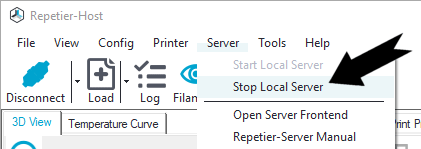
To answer the other comment, the difference is very significant depending on what you print and your print speed, the faster you print, the most off is the current build time estimation, and the most small segment you have as wellįor example, for my settings (Jerk = 8, Acceleration = 800) and a print speed (goal) of 50mm/s (3000mm/min), the time given by the build estimate in S3D is : Time for half segment = time-to-goal-speed + time-at-constrabt-speed Time-at-constant-speed = dist-const-speed / Vgoal Now the part I forgot in my original post: the remaining distance at constant speed is : dist-const-speed = half-segment-size - distance-until-reach-goal-speed With that we use the same equation as above: distance-until-reach-goal-speed = Jerk x time-to-goal-speed + (Acceleration^2 x time-to-goal-speed) /2 If there is no constant speed, the time to print the segment is 2 x delta-time found above, otherwise we need to do some more calculations (I did make at least one mistake in my original post):įirst let's see how much distance we have travelled until reaching the wanted speed, for that we need to know the time until reaching the goal speed, this is simple time-to-goal-speed: =(Vgoal - Vstart) / acceleration. Then when we have the delta-time value, we have to see if we are in a case where it's accelerating until the mid point and deccelerating after, or if you reach the print speed, and stay there for a while until you deccelerate (for short segments and high print speed, you never reach the goal speed). So we solve the equation for Vstart = jerk, Acceleration = acceleration setting, and distance = half segment size We need to find the delta time (for a half segment since the process is Start at jerk speed, accelerates, eventual constant speed, deccelerate and stop from jerk point). The equation is : distance = Vstart x delta-time + (Acceleration^2 x delta-time)/2 Well, in 3d printing jerk isn't the derivative of the acceleration as the definition states, but just the initial instantaneous speed, so if jerk is set to 10, it means the stepper will start immediately at 10mm/s and accelerate from there. Even if I assume vi=0, I still don't come out with the same results.Ĭan you elaborate on where your quadratic equation came from? Based on the above, I would think the solution would be a cubic equation with no simple solution. However, I'm not sure where your quadratic equation came from based on that. rate of change of acceleration), and t = time


Where s = distance traveled, vi = initial velocity, ai = initial acceleration, j = jerk (i.e. The simple 1D kinematic equation for distance including jerk is: I'm a bit rusty but the idea is thereĬompoundCarl wrote:So I'll try to help out a bit with some rusty physics I apologize if I made a misake int he above.

would be great of you could insert these simple formula in the calculation, or make it optional ("accurate build time calculation" option) That should give pretty accurate print time. If A (J + u) > S (we need to cap the speed) then T = 2 x ( (S-J) / A + (time to print remains of half segment after acceleration) ) (Edit, second part was missing, see my comment on post #4 which explains the detail of this calculation) (The above is the valid solution of quadratic equation (A) u^2 + J u - (L/2) = 0 ) Time for half segment (as print has to accelerate and deccelerate) acording to jerk (initial speed) and acceleration, lets call it u : u= (- J + SQRT(J^2 + 2 A L)) / 2 A (Edit: Corrected a mistake) For a print where there are many small segments this becomes very off reality.Ĭould you add 2 fields : Acceleration and Jerk for an accurate calculation of the print time?Įxample calculation change (assume length in mm, speed & jerk in mm/s and acceleration in mm/s^2), L = segment length, S = print/movement speed, A = acceleration setting, J = jerk setting (instantaneous speed), T = segment print time The cause is that the calculation is done on linear print speed not counting any acceleration or jerk. Actual Build time is always way off what is estimated, sometimes as much as the double as estimated.


 0 kommentar(er)
0 kommentar(er)
